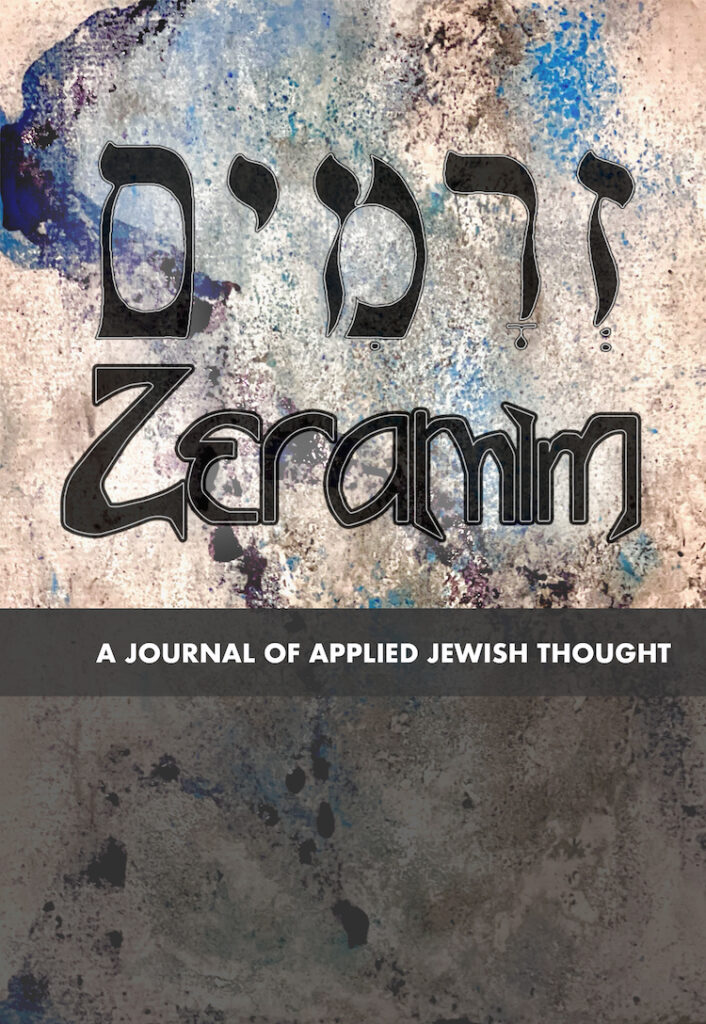
ZERAMIM: A JOURNAL
OF APPLIED JEWISH THOUGHT
VOL. VI: ISSUE 1
Fall 2021 / 5782
November 19, 2021
To our readers:
We hope that you are all vaccinated, and ready to address the challenges of emerging from the closed-in world of the past many months.
A characteristically ‘Jewish’ way of addressing such a challenge is to return to our ‘old’ stories — for, as Dara Horn recently noted, in her wonderful new book (People Love Dead Jews, at 79), ‘Jewish’ stories are often “stories without conclusions, but full of endurance and resilience …; the beginning of the search for meaning rather than the end.”
And each of our authors in this issue has focused on such a story. In ‘reverse chronological order’:
Professor Norman K. Swazo discusses how Rabbi Milton Steinberg (1903-1950) — perhaps the leading theologian of his cohort — was unable to address the Shoah philosophically, but rather, Dr. Swazo suggests, sought to respond to the challenge of human suffering through his novel, As A Driven Leaf, in which Steinberg incorporated and modified various Talmudic stories concerning the early Rabbi (around 135 CE) Elisha ben Avuyah.
Daphna Oren, in an excerpt from her recent Masters thesis in Jewish Studies, offers a new look at the story of the Rabbinic debate over the purity status of the ‘Oven of Akhnai’ — and the disastrous consequences of that debate, as the story of that debate was retold by the last editors of the Babylonian Talmud (i.e., by the “stam’aim,” in around 700 CE). And Ms. Oren suggests that the retelling was indeed intended as a self-criticism of the ‘ideal’ of academic debate — and even of God, as supervisor of that debate — when that debate forgets the fundamental values of community and mutual respect.
Allen Lipson, now a Rabbinic student at Hebrew College (Boston), focuses on an early midrash (attributed to R. Shimon bar Yohai, 2nd Cent. CE), asking why God first appeared to Moses in the form of a lowly, and burning, thorn bush. The midrash suggests that God did so to dramatize to Moses how God too suffers when Israel (and indeed humanity) suffers. And Lipson seeks to make sense of this teaching, on a very personal level, within a Jewish framework.
Finally, Professor Richard Damashek returns to one of our oldest stories — the Biblical narrative of Adam and Eve in the Garden of Eden. Dr. Damashek, drawing upon recent ‘feminist’ scholarship, demonstrates just how equivocal and open-ended the Biblical story is — e.g., noting how God, near the end, fashions clothing to protect Adam and Eve as they prepare to face a real world, as opposed to an idyllic but shut-in Garden. And Dr. Damashek then suggests a post-modern reading of the story — which perhaps may resonate with us as we emerge into the post-pandemic world.
We suggest that these analyses, and the underlying stories that they address, illustrate more generally the essential “resilience of Judaism — and why we need today to turn and return to our ‘stories,’ to provide us with insight and strength going forward.
Ḥazak, and thanks, to our authors and readers.
Yours,
The Editors
TABLE OF CONTENTS:
Richard Damashek, Ph.D.
THE CRY FROM THE THORNBUSH: ON THE PAIN OF GOD’S BODY
Allen Lipson
ARGUMENTATION AND ITS LIMITS: A LESSON FROM THE STAM
Daphna Oren
“DEATH” IN THE LITERARY IMAGINATION: RABBI MILTON STEINBERG’S AS A DRIVEN LEAF
Norman K. Swazo, Ph.D.






